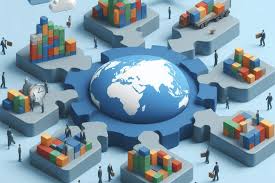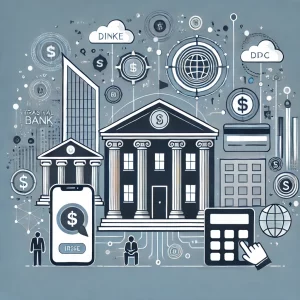How Blockchain is Revolutionizing Global Trade

Global trade has long been the cornerstone of the world economy, facilitating the movement of goods, services, and capital across borders. However, the traditional methods of conducting trade are burdened by inefficiencies, fraud risks, and a lack of transparency. This is where blockchain technology comes into play. Blockchain, a decentralized, immutable ledger system, has the potential to revolutionize global trade by making transactions more secure, transparent, and efficient.
In this article, we explore how blockchain technology is transforming the way businesses and governments engage in international trade, addressing some of the long-standing challenges in the industry.
1. Understanding Blockchain Technology
At its core, blockchain is a distributed ledger that records transactions across multiple computers in a way that makes it nearly impossible to alter or tamper with the data once it has been recorded. Each transaction, or “block,” is linked to the previous one, forming a chain of blocks. This chain is maintained by a network of computers (nodes), and all participants have access to the same data, ensuring transparency and accountability.
What makes blockchain particularly powerful in the context of global trade is its ability to create trust without the need for intermediaries. The decentralized nature of blockchain means that transactions can be verified and processed quickly, reducing the need for third parties like banks, clearinghouses, and other intermediaries that traditionally slow down trade.
2. Enhancing Transparency and Reducing Fraud
One of the biggest challenges in global trade is ensuring transparency across the entire supply chain. Traditional trade processes often involve multiple parties, such as manufacturers, suppliers, customs authorities, banks, and logistics companies, each of which maintains their own records. This fragmented system can lead to errors, delays, and fraud.
Blockchain addresses this issue by providing a single, shared ledger that is accessible to all parties involved. Since blockchain records every transaction in an immutable way, it becomes nearly impossible to alter the information once it is recorded. This provides a transparent view of the entire supply chain, allowing stakeholders to track goods from their point of origin to the final destination.
For example, if a product is shipped from one country to another, all participants in the trade process—such as the manufacturer, customs agents, freight forwarders, and distributors—can access real-time updates on the location and status of the goods. This reduces the potential for fraud and miscommunication, ensuring that all parties are on the same page.
3. Streamlining Documentation and Paperwork
Global trade is notorious for its heavy reliance on paperwork, which can slow down transactions and increase the risk of errors. Documents such as invoices, bills of lading, letters of credit, and customs declarations are often exchanged manually, leading to delays and administrative costs.
Blockchain simplifies this process through the use of smart contracts. These are self-executing contracts with the terms of the agreement directly written into code. When certain conditions are met, such as the receipt of goods or payment, the contract is automatically executed without the need for human intervention.
For instance, in a typical international trade transaction, the seller and buyer may have to exchange several documents and wait for approval from various authorities before the transaction can proceed. With blockchain and smart contracts, the process can be automated, reducing the time spent on paperwork and ensuring that all documents are securely stored and easily accessible. This not only speeds up the process but also reduces the likelihood of human error and fraud.
4. Improving Payment Systems and Reducing Costs
Cross-border payments have historically been a cumbersome and expensive process due to the involvement of multiple intermediaries, each of which charges fees. These payments can take several days to process and are often subject to fluctuating exchange rates.
Blockchain has the potential to transform international payments by enabling faster, cheaper, and more secure transactions. Cryptocurrencies like Bitcoin, Ethereum, and Ripple are already being used as a means of transferring funds across borders. These cryptocurrencies operate on blockchain networks, which allow for instantaneous transactions without the need for intermediaries like banks or clearinghouses.
For example, using Ripple’s XRP network, businesses can send payments across borders in a matter of seconds, compared to the typical 3-5 days it takes for traditional bank transfers. Blockchain-based payment systems also reduce the cost of remittance fees, which can be significant in traditional banking systems.
Moreover, by using blockchain to settle payments directly between buyers and sellers, businesses can avoid costly transaction fees associated with credit cards and wire transfers. This results in lower costs for businesses and consumers alike, making international trade more accessible.
5. Facilitating Trade Finance
Trade finance refers to the financing of goods and services in international trade, which typically involves issuing letters of credit, trade guarantees, and other forms of payment assurance. This process is often slow and relies heavily on banks and financial institutions, which can make it expensive for small and medium-sized enterprises (SMEs) to engage in international trade.
Blockchain technology can streamline trade finance by providing an immutable and transparent record of financial transactions. Through the use of blockchain-based platforms, trade finance can be digitized, allowing businesses to secure financing more efficiently. These platforms can verify the authenticity of trade documents, such as invoices and letters of credit, in real-time, reducing the risk of fraud and improving access to credit for businesses.
For example, We.Trade, a blockchain-based trade finance platform, allows SMEs to access trade finance by providing real-time, secure information about their transactions. The platform uses smart contracts to automate payments and reduce the reliance on banks for letter-of-credit issuance. This reduces the time and cost of financing, making it easier for small businesses to engage in global trade.
6. Reducing Supply Chain Complexity
Global supply chains often involve many different stakeholders, from raw material suppliers to manufacturers, wholesalers, and retailers. Managing this complexity can lead to inefficiencies, delays, and higher costs. Blockchain can simplify supply chain management by providing a single source of truth for all participants. This allows for greater coordination and faster decision-making.
For instance, a blockchain-based supply chain platform can track the movement of goods in real time, automatically updating the status of shipments as they progress through different stages of the supply chain. This reduces the need for manual data entry and ensures that all parties have access to the same information.
Additionally, blockchain’s ability to provide real-time, tamper-proof records ensures that products are sourced ethically and legally. Consumers and regulators can track the provenance of goods, verifying that they meet quality standards and are free from human rights violations or environmental harm.
7. The Future of Blockchain in Global Trade
While blockchain has already demonstrated its potential to transform global trade, its full impact is still unfolding. As more businesses, governments, and financial institutions adopt blockchain technology, the global trade ecosystem will become more efficient, secure, and transparent.
In the future, blockchain could lead to the tokenization of assets, allowing for the fractional ownership and trade of goods, commodities, and even intellectual property. This could open up new opportunities for investors and create more efficient markets.
Additionally, the integration of blockchain with Internet of Things (IoT) devices could enable the automated tracking of goods from production to delivery, creating a seamless, fully digital supply chain. This would further reduce costs, improve transparency, and increase the speed of global trade.
Conclusion
Blockchain is revolutionizing global trade by addressing many of the inefficiencies, fraud risks, and transparency issues that have plagued the industry for years. Through the use of smart contracts, real-time tracking, and decentralized payment systems, blockchain is making international trade faster, cheaper, and more secure. As the technology continues to evolve, it will reshape the way businesses, governments, and financial institutions engage in global commerce, leading to a more connected, efficient, and trustworthy global economy.




